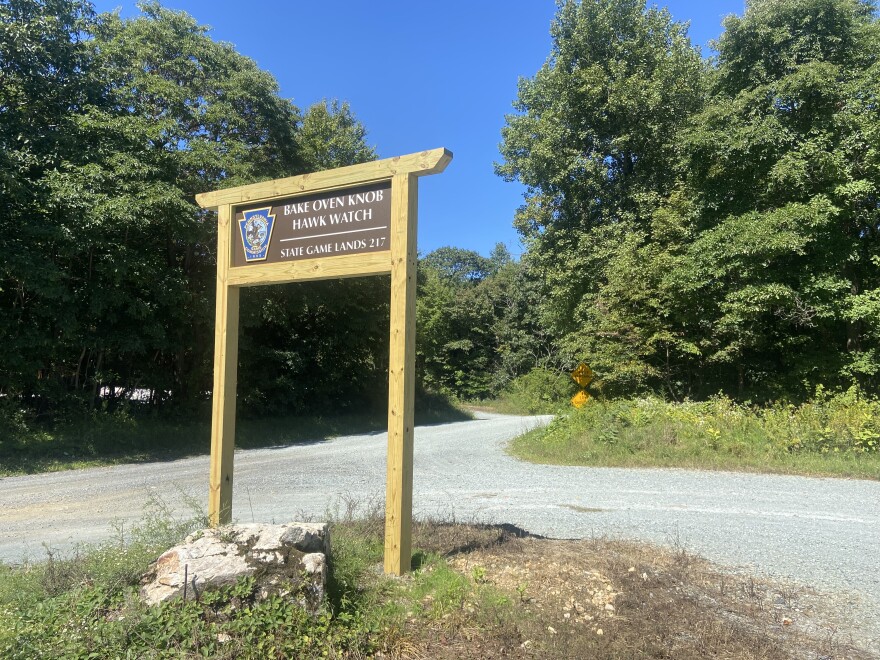- More than 1,000 migrating raptors have so far been recorded during this year's Bake Oven Knob Autumn Hawk Watch
- The count is an annual conservation research effort to keep tabs on raptor populations
- Volunteers are still needed
GERMANSVILLE, Pa. — The sky was clear and breathtakingly blue Thursday morning at the North Lookout of Bake Oven Knob — not the most ideal conditions for counting raptors.
“Clouds can create contrast,” said Justin Biggerstaff, a counter with the Lehigh Gap Nature Center. “Without the clouds, [the raptors] can really blend in.”
“But, it’s still a decent day.”
A month into this year’s Bake Oven Knob Autumn Hawk Watch, the team of counters at the center has so far recorded more than 1,000 migrating birds of prey, not including the dozens logged Thursday morning. With two-thirds of the season still ahead, volunteers are needed to continue the decades-long tradition of conservation research on the Raptor "superhighway" in the Lehigh Valley’s backyard.
“This week, we are eagerly anticipating the peak of the broad-winged hawk migration,” said Chad Schwartz, the center’s executive director. “Sometime between now and Sept. 20, several thousand of these little cousins of the red-tailed hawk will likely pass by the hawk watch on their long journey south."
“To those of you who have joined us at the hawk watch already this season, welcome. And for those who haven’t yet had a chance, we invite you to check it out.”Chad Schwartz, executive director of Lehigh Gap Nature Center
“To those of you who have joined us at the hawk watch already this season, welcome. And for those who haven’t yet had a chance, we invite you to check it out.”
‘They use the wind’
It’s about a half of a mile hike uphill along the Appalachian Trail from the parking lot at the trailhead to the North Lookout. The closer to the lookout, the rockier the terrain becomes, including a couple scrambles, forcing hikers to navigate past steep boulders.

At the North Lookout, also called “The Point,” the views are spectacular — counters and observers have an unobstructed view to the northeast along the Kittatinny Ridge, as well as to the north and west.
Before 9:30 a.m., an osprey and a sharp-shinned hawk were recorded. A single goose, as well as a vulture, were also spotted, the former not included in the count.
Biggerstaff, along with Nick Harms, the center’s seasonal stewardship outreach specialist, worked as a team to count and record. Harms acted as a spotter of sorts, sweeping over the landscape with his binoculars while Biggerstaff identified the raptors and completed the log.
“If they’re at the wrong angle, you can’t see them at all,” Harms said. “They just blend in.”
Around 10 a.m., broad-winged hawks started flying through, some singular and others in groups of as many as four or five.
“If it’s high up in the air, it’s hard to see,” Biggerstaff said, shielding his eyes from the sun before bringing his binoculars to his eyes to scan the sky. Not long after, he spotted another broad-wing.
Raptor counting is really hard when there are no, or few, clouds. I’m learning that clouds create contrast so raptors are easier to spot. pic.twitter.com/Zru6Bspc3M
— Molly Bilinski, artisanal sentence crafter (@MollyBilinski) September 14, 2023
The winds were strong, whipping through the trees and over the mountain — a good sign for counters.
“The higher the wind, the more birds, because they use the wind,” Biggerstaff said. “On days when there is no wind, there’s few flying.”
The broad-wings kept coming, punctuated by a few bald eagles. In an hour, about two dozen broad-wings were recorded. Before noon, there were more than 40 counted and recorded, as well as a handful of bald eagles and sharp-shinned hawks.
There were even a few monarch butterflies spotted — also making their annual migration south to overwinter.
“[Monarchs] use the same wind,” Biggerstaff said.
Why count raptors?
Annual counts help researchers track the status of raptor populations — and the center’s count has been going strong for 60 years.
While once considered endangered, bald eagle and peregrine falcon populations have in recent years shown strong growth. However, researchers are still keeping watch for other raptors that are threatened by habitat loss.
The center’s annual fall count is part of the Kittatinny Raptor Corridor Project, an interstate conservation effort. Data from the count is also reported to the Hawk Migration Association of North America to help inform researchers focused on global conservation efforts.
Interested in volunteering at the Bake Oven Knob Hawk Watch? Email mail@lgnc.org.


